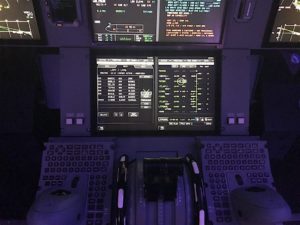
TOULOUSE, France – Thales provided details about its next generation flight management system (FMS), PureFlyt, which executives and avionics engineers here at its avionics headquarters explained will be the aviation industry’s first FMS with open world connectivity embedded in its architecture and functionality.
Expected to enter into service by 2024, Thales’ avionics engineering team first started designing PureFlyt in 2015 and has already amassed 100 million actual flight hours using a new machine learning approach to testing its capabilities with real flight data, waypoints and airports. Peter Hitchcock, vice president of commercial avionics for Thales, told journalists PureFlyt will not only be capable of 4D trajectory operations adding time to the three traditional spatial dimensions used for aircraft positioning updates, but will also be the first FMS capable of 5D trajectory, constantly proposing an optimal flight path for pilots to follow by accounting for changes in an aircraft’s weight as it burns fuel along a given route.
“In the past, the flight management system used to require a dedicated computer,” Hitchcock said. “With Pureflyt, now we’ve made such progress that we don’t need it to run on a dedicated computer. We could run it alongside other systems on a shared computer using the concept of integrated modular avionics. We don’t lose security or performance doing this, but we can probably save 20 kilos of weight on every flight by eliminating the dedicated computer and putting it in an IMA network.”
A final design architecture has not yet been solidified by Thales’ engineering team, however Hitchcock and others behind the development of PureFlyt indicate that it will feature two dedicated computers for redundancy that are always checking each other for accuracy. The design team currently has the software and operating system for PureFlyt running on a mock Airbus A350 cockpit in a development lab where it is controlled through two touchscreen displays and is synced with connected electronic flight bag (EFB) running the company’s Aviobook flight optimization application.
Described by Thales as a “technological breakthrough,” a unique design element of PureFlyt is the embedded connected and processing aspects, which are capable of feeding all of the various elements of the global air traffic ecosystem into an aircraft’s flight plan in real time. The company also wants the new FMS to be aircraft agnostic, indicating that it will be available as a line-fit production option or retrofit application on future military airplanes as well.
The Airbus A400M already features the current generation FMS from Thales, and the defense version of PureFlyt will build off of that.
“We’re not necessarily talking about jet fighters, we’re talking more of the military air transport type of aircraft,” said Chris Wiehelen, head of avionics strategy for Thales, on military applications for PureFlyt. “For instance, today I would say it’s evolving, but just even 10 years ago you had to have segregated airspace dedicated to military flights because they were not adapted to civilian air routes. Here we’re talking about the means, depending on something like an emergency crisis in a certain country for example, military airplanes could land on the same airports as civilian airplanes at the same time, not locking major airspace. In some parts of the world, airspace will become rare, and therefore the military corridors will probably become narrower over time in order to have the amount of space needed for the amount of aircraft that are needed.”
How connected will PureFlyt ultimately be when it enters into service remains to be seen, though. Thales officials declined to comment on whether a router or modem would be embedded into the new FMS when it enters into service, which would enable it to connect to effectively any “open world” connectivity network, such as the air to ground or satellite-based in-flight connectivity services offered by companies such as Gogo, SmartSky or ViaSat [VSAT].
“I don’t see that happening in the first phase,” Wiehelen said, when asked whether PureFlyt will use cabin connectivity systems. “I would say more from certified satcom, from the likes of Inmarsat or Iridium. Simply because the environment is conservative and it needs to be certified.”
While most of the functionality of PureFlyt demonstrated during the unveiling discussed specific airline applications and usage, the company is developing the system to be ready for variants on military air transport aircraft, helicopters and even to be available as a retrofit.
Jean-Paul Ebanga, vice president of flight avionics for Thales, said that the development of PureFlyt was also created with the millennial generation of pilots that will become the majority of those in commercial airliner cockpits over the next 20 to 30 years. Ebanga said Thales does not see the need to develop military specific applications, because the open world architecture of PureFlyt allows it to be customized based on the aircraft it is being installed on.
“What we see in terms of trend is that more and more military aircraft will share the same airspace as commercial planes,” Ebanga said. “So all the functionalities offered on the commercial aircraft will be or should be available for the military because of the need to share the same airspace traffic concession. The second point I would mention is that our solution is also based on the A400M FMS, which is today the leading FMS in the military market and PureFlyt will share the same type of DNA as the A400M.”
This article was originally published in our sister publication Aviation Today.